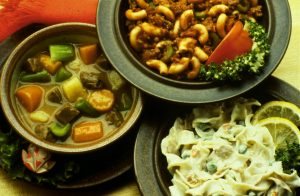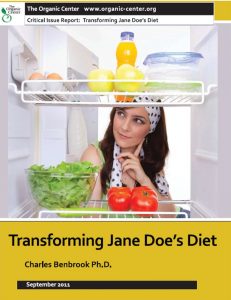- Quantifying the Impact of Plant Genetics and Production Systems
- A New Tool to Promote Food Security
- Transforming Jane Doe’s Diet
- Nutritional Quality Index (NQI)
Introduction

Nutrient profiling systems (NPS) are designed and applied to quantity the nutritional quality of one food compared to others. NPSs can be applied to compare foods, assess the adequacy and excesses in daily food choices, and track changes in food or diet quality over time. Likewise, NPSs can help quantify the impacts of changes in prices, accessibility, food forms, technology, and policy on food and overall dietary nutritional quality.
The basic metric produced by a nutrient profiling system can be applied to a single serving of a given food, and then compared to a serving of other foods. Other applications focus on a 100-calorie portion of different foods, or a given volume of food (e.g., a 100-gram serving). Each of these three ways to compare the nutrient content of food tends to favor some classes of foods over others.
For example, when comparing foods by weight (equal 100-gram servings), all dried foods, or those that lack moisture content, will score relatively high in nutrient content per gram. However, foods containing a lot of moisture will tend to score lower, since water is heavy and contains no nutrients.
Or, foods that have few calories per gram or serving, like leafy greens or onions, score very high when nutrient profiling system results are expressed per 100 calories, whereas calorie-dense foods, like oils, score poorly.
Food companies are beginning to add new front-of-label messaging based on rankings from a nutrient profiling system. Some retailers are working on new systems for application to their house brands.
Related Keywords:
Quantifying the Impact of Plant Genetics and Production Systems
None of the currently utilized nutrient profiling systems have been used to quantify the impact of crop genetics, farming systems, or how crops are stored, cooked, and served on nutrient density. These are important, emerging areas of research, and will help quantify and place into perspective:
- The nutritional quality of modern crop cultivars, in contrast to either heirloom varieties or genetically modified crops.
- The omega-fatty-acid related benefits of organic and grass-based dairy and meat production.
- The best methods to boost and retain antioxidant activity in fruits and vegetables as they undergo storage and processing.
A New Tool to Promote Food Security

How will the world produce enough food to feed the expected, peak human population of around 9 billion? This challenge looms large.
One of the soundest, proven strategies is to shift highly productive cropland from crops that produce relatively few “Human Nutrition Units” per acre/hectare to those that produce several-fold more.
“Human Nutrition Units” (HNUs) are calculated by multiplying the NQI score for a pound or kilogram of the edible foodstuffs produced on an acre/hectare, by the total pounds/kilograms of the food grown on an acre/hectare. Nutrient dense and/or high-yielding crops produce relatively more HNUs than less nutrient dense or lower yielding crops.
For example, sweet potatoes score exceptionally high in terms of HNUs per acre/hectare, while corn fed to beef in a feedlot scores far lower. Studies assessing changes in HNUs produced from a given land area can help answer complex questions regarding the consequences of alternate strategies and paths to promote food security, for example:
- Will genetically engineered Golden rice or conventionally bred high-vitamin A corn more effectively boost Vitamin A intakes in Africa?
- Can indigenous fruits and vegetables compete with modern varieties of corn, rice, and wheat in promoting food security?
- Do intensive agricultural systems based on monocultures and specialization, or diverse, multi-cropping systems have the greatest potential to contribute to sustainable food security?
Related Keywords:
Transforming Jane Doe’s Diet
 Jane Doe is 30 years old and gained 10 pounds in her 20s. She is determined to prevent any further weight gain, because she is planning for her first pregnancy. She also knows that even very low levels of pesticide exposure during the first trimester of pregnancy can trigger developmental deficits with lifelong consequences.
Jane Doe is 30 years old and gained 10 pounds in her 20s. She is determined to prevent any further weight gain, because she is planning for her first pregnancy. She also knows that even very low levels of pesticide exposure during the first trimester of pregnancy can trigger developmental deficits with lifelong consequences.
To increase the odds of a healthy pregnancy and baby, Jane Doe decides to assess her typical dietary choices, and make some changes that will simultaneously improve the nutritional quality of her diet, and reduce pesticide dietary exposure and risk.
In a September 2011 report issued by The Organic Center, (also available as a two-page summary here) we modeled the impact of a set of surprisingly modest changes in Jane Doe’s typical diet, using the “Nutritional Quality Index” to quantify the nutritional quality of her “before” and “after” changes in her daily food choices, as well as the ”Dietary Risk Index” to estimate changes in her cumulative pesticide dietary risk.
Jane Doe’s “after” diet included several smarter, yet modest food changes. These include replacing a few high-calorie foods with nutrient-dense fruit and vegetable-based products, and purchasing mostly organic fruits, vegetables, and grain-based products.
Over half of Jane’s “before” diet remained unchanged. However, by making a few simple changes, her daily intake of fruits and vegetables rose from 3.6 servings to 12.3 servings.
The overall nutritional quality of her diet rose by 79 percent, based on the changes in intakes across 27 essential nutrients.
By switching to mostly organic fruits and vegetables, her pesticide risk was reduced by over two-thirds. Plus, Jane Doe consumed 10 fewer calories per day, enough of a reduction to prevent long-term weight gain.
Nutritional Quality Index
Hygeia Analytics will present several applications of a NPS called the (NQI), developed by Chuck Benbrook and Don Davis with support from The Organic Center. The 2011 NQI methodology report is available on Hygeia Analytics as a two-page summary and full report which details the mathematics of the NQI and data sources tapped to apply it.
The Nutritional Quality Index (NQI), is one of several nutrient profiling systems that quantify the relative nutritional contribution of one food in contrast to others.
The nutritional quality of food is generally compared in three ways:
- According to typical single-serving size (i.e., 30 grams, 50, or 125 grams);
- Per calorie, or 100 calories of each food; or
- Per gram, or 100 grams of each food.

My colleague Dr. Don Davis and I calculated NQI values per 100 grams, per 100 calories, and per serving for 196 common foods, in response to media inquiries following the release of The Organic Center report “Transforming Jane Doe’s Diet”.
The Excel spreadsheet linked below reports the USDA serving size in grams for each food, the calories per serving, and the reference number in the official USDA database on the nutrient content of food, from which we extracted the nutrient levels used in calculating NQI values.
The spreadsheet then identifies the nutrients accounting for the largest, second largest, and third most significant share of the total NQI value for each food. The last two columns report nutrients for which NQI values were truncated after meeting an individual’s daily needs, as well as how ORAC (a measure of total antioxidant activity) values were established or estimated.
NQI Values for 196 Foods, Ranked By NQI per 100 Calories

